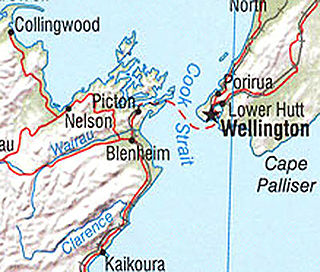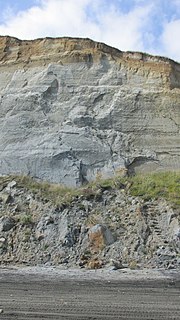 W
WCurio Bay is a coastal embayment in the Southland District of New Zealand, best known as the site of a petrified forest some 180 million years old. It also hosts a yellow-eyed penguin colony, arguably the rarest of penguin species, with approximately 1600 breeding pairs in the extant population. The bay, along with neighbouring Porpoise Bay, is home to the endemic Hector's dolphin. Southern right whales are occasionally observed offshore, as on numerous parts of the country's coast. Located near the southernmost point of the South Island, Curio Bay is one of the major attractions in the Catlins, attracting around 100,000 visitors per year. The town of Waikawa has an information center for tourists.
 W
WFoulden Maar, a fossil site near Middlemarch in Otago, New Zealand, formed in a volcanic eruption 23 million years ago. The resulting crater lake filled with diatomite, composed of layers of silica-shelled algae (diatoms) and exceptional fossils of plants, fishes, spiders and insects from the surrounding sub-tropical Miocene forest. As the only known maar of its kind in the Southern Hemisphere, it is one of New Zealand's pre-eminent fossil sites. A 2018 proposal to mine Foulden Maar for livestock-food additive has attracted significant public opposition.
 W
WHoneycomb Hill Cave is located in the Oparara Basin, on the northwestern edge of the South Island of New Zealand. The Oparara River flows through a section of the cave.
 W
WLake Poukawa is a small shallow hardwater lake in the Hawke's Bay Region, North Island, New Zealand. It is located about 20 km south-west of Hastings, New Zealand, close to the settlement of Te Hauke. It is the largest lake lying within a peatland in the active tectonic Poukawa depression, between the Raukawa Range and Kaokaoroa Range of central Hawke's Bay. Its maximal depth is less than one metre and its diameter is ca. 1.5 km. It was deeper in the past but it became artificially drained after the 1931 Hawke's Bay earthquake. Lake Poukawa became a well-known paleontological site in 1956 when paleontologist Russell Price began with his excavations in the lacustrine deposits. Lake Poukawa had a species rich Pleistocene/Holocene waterfowl fauna. More than 13,400 anatid bones were unearthed at this site since 1956. Extinct birds found at Lake Poukawa include Biziura delautouri, Oxyura vantetsi, Mergus australis, Chenonetta finschi, Pachyornis geranoides, Ixobrychus novaezelandiae, Gallinula hodgenorum, Fulica prisca, Malacorhynchus scarletti, and Cnemiornis gracilis.
 W
WThe St Bathans fauna is found in the lower Bannockburn Formation of the Manuherikia Group of Central Otago, in the South Island of New Zealand. It comprises a suite of fossilised prehistoric animals from the late Early Miocene (Altonian) period, with an age range of 19–16 million years ago.
 W
WThe Wairau Bar, or Te Pokohiwi, is a 19-hectare (47-acre) gravel bar formed where the Wairau River meets the sea in Cloudy Bay, Marlborough, north-eastern South Island, New Zealand. It is an important archaeological site, settled by explorers from East Polynesia who arrived in New Zealand about 1280. It is the earliest known human settlement in New Zealand. At the time of the occupation it is believed to have been a low scrub-covered island 2 to 3 metres high, 1.1 kilometres (0.68 mi) long and 0.4 kilometres (0.25 mi) wide.
 W
WThe Wanganui Basin is an onshore-offshore basin on the North Island of New Zealand. The basin provides an important stratigraphic and palaeontological record for the late Neogene marine environment of New Zealand.